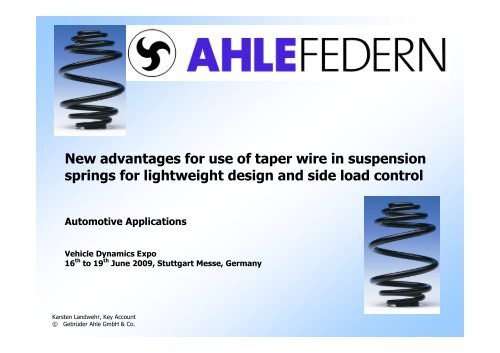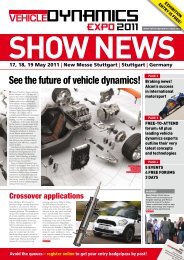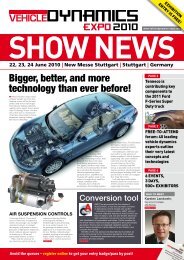Side-Load Spring - Vehicle Dynamics Expo
Side-Load Spring - Vehicle Dynamics Expo
Side-Load Spring - Vehicle Dynamics Expo
Create successful ePaper yourself
Turn your PDF publications into a flip-book with our unique Google optimized e-Paper software.
New advantages for use of taper wire in suspension<br />
springs for lightweight design and side load control<br />
Automotive Applications<br />
<strong>Vehicle</strong> <strong>Dynamics</strong> <strong>Expo</strong><br />
16 th to 19 th June 2009, Stuttgart Messe, Germany<br />
Karsten Landwehr, Key Account<br />
© Gebrüder Ahle GmbH & Co.
Agenda<br />
1) <strong>Spring</strong> design requirements<br />
2) Realization of Miniblock-<strong>Spring</strong>s<br />
3) The Ahle manufacturing process<br />
4) Summary Miniblock-<strong>Spring</strong>s<br />
5) New developments / potential of springs with non-constant wire<br />
diameter<br />
6) Summary<br />
Karsten Landwehr, Key Account<br />
© Gebrüder Ahle GmbH & Co.
Karsten Landwehr, Key Account<br />
© Gebrüder Ahle GmbH & Co.<br />
1. <strong>Spring</strong> Design<br />
Requirements
Karsten Landwehr, Key Account<br />
© Gebrüder Ahle GmbH & Co.<br />
Customer Requirements to <strong>Spring</strong> Design<br />
1. (Progressive) Deflection Curve<br />
2. Light Weight Design<br />
3. Packaging Minimisation<br />
4. No Coil Contact<br />
5. Super Progression<br />
6. Low <strong>Side</strong> <strong>Load</strong><br />
7. Characteristic of the <strong>Load</strong> Deflection Curve
<strong>Spring</strong> Design Requirements<br />
Requirement: Solution:<br />
1. (Progressive) deflection curve<br />
2. Light weight design<br />
3. Small nstallation space<br />
4. No coil contact<br />
5. Super progression<br />
6. Low side load<br />
7. Characteristic of the loaddeflection<br />
curve<br />
Karsten Landwehr, Key Account<br />
© Gebrüder Ahle GmbH & Co.<br />
Non-constant pitch:<br />
• Progression<br />
Non-constant wire diameter:<br />
• Weight reduction: light weight design<br />
Non-constant coil diameter:<br />
• Small block length (Miniblock spring)<br />
• No coil contact (contact elimination)
The Non-Constant Principle<br />
Karsten Landwehr, Key Account<br />
© Gebrüder Ahle GmbH & Co.<br />
Combination of:<br />
•Non-constant pitch<br />
•Non-constant coil diameter<br />
•Non-constant wire diameter<br />
resulted in the design of the<br />
Miniblock spring
Miniblock <strong>Spring</strong> Types<br />
Karsten Landwehr, Key Account<br />
© Gebrüder Ahle GmbH & Co.<br />
Progressive Miniblock <strong>Spring</strong><br />
The spring is symmetrical.<br />
The coils are supported on both sides of the spring disks.<br />
Linear Miniblock <strong>Spring</strong><br />
And one-sided<br />
progressive spring!<br />
The spring is symmetrical.<br />
The coils are not spported on the spring disks.
Karsten Landwehr, Key Account<br />
© Gebrüder Ahle GmbH & Co.<br />
2. Miniblock <strong>Spring</strong> Design
Complex Customer Requirements<br />
Example: realistic packaging and circular arc deflection<br />
Offset Axles<br />
Axle offset<br />
Circular<br />
Circular<br />
arc<br />
arc<br />
deflection<br />
deflection<br />
Karsten Landwehr, Key Account<br />
© Gebrüder Ahle GmbH & Co.
Design and Calculation Methods<br />
� Ahle <strong>Spring</strong> Design Algorithm<br />
� Ahle Tool Design Algorithm<br />
� FEM (Femap/Nastran)<br />
� CAD (ProEngineer)<br />
� 3-D Measurement (DEA/Hexagon)<br />
� Integrated Tooling and Prototype Manufacturing<br />
Karsten Landwehr, Key Account<br />
© Gebrüder Ahle GmbH & Co.<br />
Hf
<strong>Spring</strong> Design Algorithm<br />
Evaluation of geometry data and<br />
characteristic curve<br />
Karsten Landwehr, Key Account<br />
© Gebrüder Ahle GmbH & Co.
Tooling Algorithm<br />
CAM link to tool design<br />
Karsten Landwehr, Key Account<br />
© Gebrüder Ahle GmbH & Co.
Finite Element Simulation<br />
Karsten Landwehr, Key Account<br />
© Gebrüder Ahle GmbH & Co.<br />
Model of a Miniblock-<strong>Spring</strong>
FEM Simulation<br />
FEM simulation helps to analyse stresses (bending and torsion stresses)<br />
within spring wire during designing<br />
Karsten Landwehr, Key Account<br />
© Gebrüder Ahle GmbH & Co.<br />
FEM Simulation
CAD (Pro-Engineer)<br />
Karsten Landwehr, Key Account<br />
© Gebrüder Ahle GmbH & Co.<br />
Generation of CAD drawings to<br />
transfer the spring design into<br />
the customer‘s CAD system
Tooling / Prototype Development<br />
Product development is<br />
close to series production<br />
Karsten Landwehr, Key Account<br />
© Gebrüder Ahle GmbH & Co.<br />
Checking deflection curve and load during<br />
prototype development
3-D Measurement; DEA/Hexagon<br />
Karsten Landwehr, Key Account<br />
© Gebrüder Ahle GmbH & Co.<br />
Capturing geometry data of the real spring, feedback into FEM
Karsten Landwehr, Key Account<br />
© Gebrüder Ahle GmbH & Co.<br />
3. The Ahle<br />
Manufacturing Process
Producing <strong>Spring</strong>s from Steel Bars<br />
1. Drawing and turning 2. Coiling 3. Bending Cutting 4. Plane pressing<br />
8. Shot peening<br />
Karsten Landwehr, Key Account<br />
© Gebrüder Ahle GmbH & Co.<br />
7. Warm setting<br />
Surface coating<br />
9. Pretreatment and phospating 10. Powder coating<br />
6.<br />
Tempering<br />
11. Setting and testing<br />
Processing<br />
5.<br />
Hardening<br />
12. Signing and packing
Taper Wire<br />
Typical bar drawing (taper wire)<br />
Karsten Landwehr, Key Account<br />
© Gebrüder Ahle GmbH & Co.<br />
Production of taper wire<br />
Reducing the material in a combination of<br />
drawing and peeling processes
Coiling Process<br />
Karsten Landwehr, Key Account<br />
© Gebrüder Ahle GmbH & Co.<br />
Coiling of springs
Heat Treatment<br />
Karsten Landwehr, Key Account<br />
© Gebrüder Ahle GmbH & Co.<br />
Heat treatment furnace with controlled atmosphere
Karsten Landwehr, Key Account<br />
© Gebrüder Ahle GmbH & Co.<br />
4. Miniblock <strong>Spring</strong>s,<br />
Summary
Requirement: Deflection Line<br />
Execution of every required deflection curve<br />
Karsten Landwehr, Key Account<br />
© Gebrüder Ahle GmbH & Co.<br />
The Ahle process<br />
enables the<br />
development and<br />
production of chassis<br />
springs with a rate<br />
ratio of 1:3!<br />
Rate<br />
4<br />
F G⋅<br />
d<br />
= = 3<br />
S 8⋅<br />
D ⋅n
Requirement: Light-Weight Design<br />
Solution: The wire diameter<br />
can be adjusted to the stress in<br />
this area. As soon as smaller<br />
coils have settled, the stress in<br />
these coils is reduced. The wire<br />
diameter of these coils is thus<br />
designed with a smaller<br />
diameter.<br />
Result: light-weight<br />
design<br />
The Miniblock-<strong>Spring</strong> is the lightest spring from a<br />
physical point of view and offers the lowest block length.<br />
Karsten Landwehr, Key Account<br />
© Gebrüder Ahle GmbH & Co.
Requirement: No Coil Contact<br />
No coil contact – no noise, no surface damage!<br />
Karsten Landwehr, Key Account<br />
© Gebrüder Ahle GmbH & Co.
Requirement: Small Installation Space<br />
Karsten Landwehr, Key Account<br />
© Gebrüder Ahle GmbH & Co.<br />
315.00mm
Karsten Landwehr, Key Account<br />
© Gebrüder Ahle GmbH & Co.<br />
here:<br />
Block length:<br />
47.30mm<br />
=15% of the free<br />
length L 0<br />
47.30mm 315.00mm
Requirements<br />
1. (Progressive) Characteristic Curve ����<br />
2. Light Weight Design ����<br />
3. Packaging Minimisation ����<br />
4. No coil contact ����<br />
5. Super Progression ����<br />
6. Defined Force Line Piercing Points ����<br />
- <strong>Side</strong> load minimisation (piercing points in the spring axis)<br />
- Offset (piercing points are outside of the spring axis)<br />
Karsten Landwehr, Key Account<br />
© Gebrüder Ahle GmbH & Co.
Karsten Landwehr, Key Account<br />
© Gebrüder Ahle GmbH & Co.<br />
5. New Developments/<br />
Potential of <strong>Spring</strong>s with<br />
Non-Constant Wire<br />
Diameter
New Development: Mini SPF<br />
(Super-Progressive-<strong>Spring</strong>s)<br />
Characteristic curve of a Mini –Super-<br />
Progressive <strong>Spring</strong> (Mini-SPF)<br />
Karsten Landwehr, Key Account<br />
© Gebrüder Ahle GmbH & Co.<br />
Applications (e.g.):<br />
Rebound spring<br />
Simulator spring<br />
The Ahle process<br />
makes it possible<br />
to develop and<br />
produce superprogressivesprings<br />
with a rate<br />
ratio of up to zu<br />
1:10!
Comparison: Mini SPF vs.<br />
Helical Compression <strong>Spring</strong><br />
Weight<br />
Free length<br />
Solid length<br />
Karsten Landwehr, Key Account<br />
© Gebrüder Ahle GmbH & Co.<br />
Mini SPF<br />
(Super<br />
progressive<br />
spring)<br />
71 %<br />
66 %<br />
58 %<br />
Different springs with<br />
identical properties:<br />
Helical<br />
compression<br />
spring<br />
100 %<br />
100 %<br />
100 %<br />
Material, force, initial rate, end rate,<br />
outer diameter = constant<br />
Benefit of non-constant wire<br />
diameter!<br />
Mini SPF<br />
progressive helical<br />
compression spring
Requirements<br />
1. (Progressive) Characteristic Curve ����<br />
2. Light Weight Design ����<br />
3. Packaging Minimisation ����<br />
4. No coil contact (noise elimination) ����<br />
5. Super Progression ���� ����<br />
6. Defined Force Line Piercing Points<br />
- <strong>Side</strong> load minimisation (piercing points near spring axis)<br />
- Offset (piercing points outside of spring axis)<br />
Karsten Landwehr, Key Account<br />
© Gebrüder Ahle GmbH & Co.
Objectives / Benefits of AHLE Solution<br />
• Reduction of friction within the spring system<br />
• Reduction of height / length of the spring<br />
(improved pedestrian protection!)<br />
• Optimised positioning of the shock absorber system<br />
• Reduced weight of spring<br />
• Easier assembly of the shock absorber system<br />
Karsten Landwehr, Key Account<br />
© Gebrüder Ahle GmbH & Co.
<strong>Side</strong> <strong>Load</strong> Correction<br />
Current situation<br />
The side load of a spring depends on<br />
its geometric framework conditions<br />
Solution:<br />
Selected wire sections are<br />
"thickened" to influence the<br />
direction of the force line!<br />
Karsten Landwehr, Key Account<br />
© Gebrüder Ahle GmbH & Co.<br />
Sketch: modified helical compression spring
<strong>Side</strong> <strong>Load</strong> Correction<br />
Objective achieved by:<br />
Non-constant wire diameter<br />
Karsten Landwehr, Key Account<br />
© Gebrüder Ahle GmbH & Co.<br />
Sketch: modified Miniblock-<strong>Spring</strong>
d [mm]<br />
<strong>Side</strong> <strong>Load</strong> Correction<br />
18<br />
16<br />
14<br />
12<br />
10<br />
8<br />
6<br />
4<br />
Schematic drawing of a bar with partially thickened wire sections<br />
Karsten Landwehr, Key Account<br />
© Gebrüder Ahle GmbH & Co.<br />
Su L st [mm]
<strong>Side</strong> <strong>Load</strong> Determination<br />
Karsten Landwehr, Key Account<br />
© Gebrüder Ahle GmbH & Co.<br />
Position of piercing<br />
points based on the<br />
direction of the force<br />
line of action
<strong>Side</strong> <strong>Load</strong> Minimization<br />
Karsten Landwehr, Key Account<br />
© Gebrüder Ahle GmbH & Co.<br />
Optimized force line of action of a modified Miniblock-<strong>Spring</strong>)
Influencing the Force Line of Action<br />
Karsten Landwehr, Key Account<br />
© Gebrüder Ahle GmbH & Co.<br />
Ahle – <strong>Side</strong>-<strong>Load</strong> <strong>Spring</strong> without bar modification
Influencing the Force Line of Action<br />
Karsten Landwehr, Key Account<br />
© Gebrüder Ahle GmbH & Co.<br />
Ahle – <strong>Side</strong>-<strong>Load</strong> <strong>Spring</strong> with bar modification
Current Status of Developments<br />
• Series production of partially thickened bars is possible<br />
• Confirmed functionality of the Ahle – <strong>Side</strong>-<strong>Load</strong> <strong>Spring</strong><br />
• Compared with series side-load springs the Ahle-Solution shows up<br />
to 50% larger shifts of the piercing points<br />
Karsten Landwehr, Key Account<br />
© Gebrüder Ahle GmbH & Co.<br />
Lower piercing point<br />
Xunt [mm]<br />
-32.73<br />
-33.05<br />
-44.81<br />
-47.59<br />
-48.02<br />
Yunt [mm]<br />
-2.86<br />
-1.51<br />
0.49<br />
0.63<br />
0.79<br />
Upper piercing point<br />
Yob [mm]<br />
-6.37<br />
-32.02 -2.01 -8.98 -3.89 541.61 No thickened sections<br />
-5.71<br />
-1.57<br />
-2.32<br />
-2.79<br />
Xob [mm]<br />
-3.61<br />
-2.93<br />
808.82<br />
Further development of a competitor‘s side load spring<br />
2.12<br />
1.02<br />
0.78<br />
<strong>Side</strong> load<br />
Fq [N]<br />
577.53<br />
508.58<br />
859.93<br />
825.46<br />
Wire<br />
With thickened<br />
sections
Karsten Landwehr, Key Account<br />
© Gebrüder Ahle GmbH & Co.<br />
6. Summary
Summary<br />
(Progressive) helical compression springs with taper wire<br />
show the following properties:<br />
� Optimum use of material<br />
� Low weight<br />
� Small packaging<br />
� No coil contact<br />
� High progression in only one component<br />
possibility to influence the force line<br />
Karsten Landwehr, Key Account<br />
© Gebrüder Ahle GmbH & Co.
Karsten Landwehr, Key Account<br />
© Gebrüder Ahle GmbH & Co.<br />
Thank you for your attention







